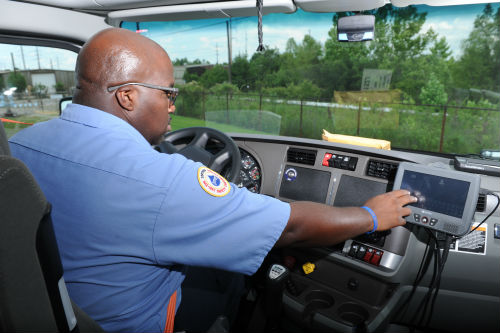New technology is transforming daily business processes for many in supply chain management. The need for real-time tracking and accurate delivery systems makes supply chain management ripe for technological innovation — and mobile, wireless, handheld technology is leading the way throughout the logistics and transportation sectors.
With the ever-changing aspect of technology, keeping up with new capabilities and best practices can be difficult for large companies who have deep investments in older technology — it is a never-ending process. Although transitions take time, leveraging new technologies is key in this competitive industry.
The following are a few of the ways in which technology is transforming supply chain management:
1. Greater Efficiency and Transparency
Shippers are under pressure to reduce supply chain costs as part of greater company cost saving initiatives. Shippers want more services and better transparency from their supply chain managers, ideally without driving up costs. Since the start of the wireless era, many third-party logistics providers (3PLs) and supply chain managers have turned to wireless technologies and cloud computing to automate systems and improve accuracy.
Not only are automated systems faster and more efficient than their manual, fax-based predecessors, the mobile and automated methodologies also provide better data-capture, which can, in and of themselves, improve processes and can also be stored and analyzed to target areas for improvement. For example, handheld mobile devices can deliver wireless proof of delivery and real time transportation monitoring, which can help managers discover and address operational anomalies. 3PLs are also turning to technology to streamline their client supply chain activity and improve client relations. The use of Customer Relationship Management (CRM) technology continues to provide easy-access dashboard visibility of supply chain operations, helping leaders to identify inefficiencies and bottlenecks in commercial operations.
Technology like radio-frequency identification (RFID) is a popular method of automatic identification and data-capture. Because RFID tags can be attached to clothing, inventory, or almost any item, the tracing possibilities are extensive and applicable to numerous aspects of the supply chain. Technology reduces labor costs by streamlining data-capture and reducing error-prone manual processes. Access to real-time, up-to-date information across the entire supply chain is having a significant impact on how companies are doing, and expect to do business. Shippers want to be able to answer the question, “When exactly will my delivery arrive?” Integrating new technologies will make answering that question much easier.
Access to real-time information has significant impact. APIs offer logistics providers the ability to interface with multiple systems in a much-improved way and decrease the amount of time it takes to get data from one point to another. By doing so, 3PL providers are enabled to use self-service portals with shippers.
The improved information flow also opens the possibility of better asset utilization providing loads to help the shipper return home with freight, reducing empty miles from the transportation network.
2. Focus on Individual Employees
Smartphone technology offers shippers and vendors the abilities to pair workers with the devices most appropriate for their daily work. As mobile devices become more diverse and varied, companies are striving to match the job with the right device. While smartphones are gaining precedence in supply chain operations, they are still subject to the wear and tear. However, ruggedized cases have increased reliability for handheld devices to withstand daily outdoor usage.
Today many asset-lite carriers leverage smartphone technology. Using apps, proprietary programs and mobile interfaces, smartphone technology uses the pings from that smartphone that’s sitting with the driver and create a breadcrumb trail of how freight is being tracked. Also, applications on the backend enable a driver to signature capture information and create a proof of delivery.
Smartphones give an open network of carriers the ability to act like a closed-fleet network. Companies are able to get the same kind of status information from a cell phone that is available via proprietary technology or in a controlled IVMS/Electronic Logging Devices (ELDs) global unit. To hear more about focusing on individual employees view here.
3. Tighter Communication and Community
Smoother and more frequent communication undoubtedly makes business operations easier. Mobile technologies and real-time communicating can create a greater sense of unity and development from those out in the field to those in corporate headquarters.
Managers are often on the move, but improved communication and access to live information can make managers more in tune with daily happenings in the supply chain.
Beyond the traditional communication options smartphones offer 3PL companies’ employees, enterprise technology systems readily available in the marketplace use pings and the information pings improve communication and provide the capabilities to make big carriers nimbler.
Strategic workforce management is especially critical for companies who are understaffed or having difficulty filling capacity. Flexible communication channels within all aspects of the supply chain can increase employee productivity and boost morale. Greater collaboration and communication ultimately boils down to better customer service. Communication aids in product tracking and delivery, which results in higher customer satisfaction with the supply chain process. When employees are connected through many stages of the supply chain, workers likely feel more fulfilled and operations often run more smoothly.
4. Making Way for Small but Nimble Carriers
Smaller firms with less investment in their current system have and will continue to find it easier to successfully integrate new technologies. Smaller fleets don’t have to spend thousands on mobile resource management or automatic vehicle location systems anymore.
Often, the job can be done with a relatively affordable mobile device or non-proprietary app, making the leap to wireless much easier. This flexibility may continue to give smaller carriers an edge, making them more agile and flexible in a competitive environment.
5. Government Requirements Tackled with New Technology
As of December 2017, the Department of Transportation requires Electronic Logging Devices for drivers and fleets. (Some companies, converting from the grandfathered AOBRD to ELD, must meet the December 2019 deadline. All others were required to move to ELD December of 2017.)
Fleets faced with stricter regulations are turning to better routing software and logistics management technology to save time and money. As the government looks towards technological solutions, supply chain managers will have no other choice but to do so as well.
6. Driver Shortage Drives New Technology
Driver Assisted Truck Platooning (DATP) could relieve some of the strain of the driver shortage by enabling one driver to “drive” several vehicles in parade formation at once. The human driver would simply operate a single truck at the head of the “platoon” and one or more similar trucks would connect with the lead truck to follow along behind autonomously. DATP has the potential to reduce carbon emissions through better miles per gallon, as well as save costs as driver wages continue to rise.
Autonomous vehicles have been working along Interstate 10 between El Paso and Southern California since 2017. For now, a human driver rides in the cab to monitor the computer chauffeur. Even though the well-documented driver shortage is real, trucks continue to carry 70 percent of goods shipped around the country. According to the American Trucking Associations, the industry is short about 50,000 drivers and that number could grow as Baby Boomers retire and possibly hit 175,000 by 2024. Self-driving trucks could help save the day to fill the gap between need and scarcity of drivers — especially considering that a self-driving truck would not be subject to ELD rules limiting humans to 11 hours at a time behind the wheel.
The gamification of trucking is also being used to improve safety and combat the driver shortage and attract a new generation of drivers. Gamification uses game mechanics and dynamics to drive engagement and key performance indicators in a non-game context — it basically uses natural instinct and reward incentives to drive or change current behavior.
7. The Effects of Internet Shopping on Last Mile Delivery
Amazon began experimenting with drone delivery in late 2016 and gained a patent for a delivery drone in early 2018. Mobile technology and APIs are already improving to the point of drones being piloted by central technology by someone not even near a particular neighborhood delivering packages to homes in the neighborhood.
Additionally, using autonomous vehicles to cross stock freight in warehouses is already happening and expected to increase as technology improves. To hear more about the effects of internet shopping on last mile delivery view here.
8. Internet-of-Things and Vehicle-to-Everything changes
The Internet of Things and Vehicle-to-Everything (technology to connect the vehicle to other vehicles, the cloud and anything else) could work together to go far beyond ELDs. These networks of technology could improve safety in numerous ways, monitor drivers’ health, assist with lane changes and more as information is passed between a vehicle and an entity on the road — a traffic light, crosswalk or other signs.
More specific forms of this technology include connecting Vehicle-to-Cloud (V2C), Vehicle-to-Pedestrian (V2P) and Vehicle-to-Grid (V2G). These technologies could improve safety on the road as well as driving efficiency. To hear more about the internet of things and vehicle to changes view here.
Dupré Logistics is a privately held, asset-based provider of transportation and logistics services that include energy and chemical transport, dedicated truck transportation, site logistics, and freight brokerage. We specialize in tanker, hazmat, and petrochemical transportation and complex supply chain solutions in industrial and consumer products.

